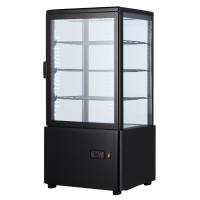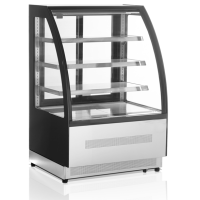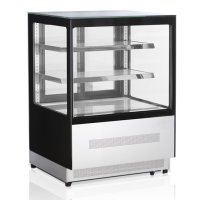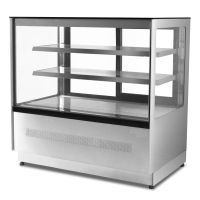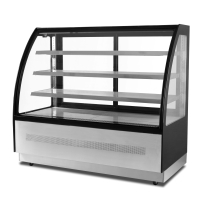Refrigerated Cake Displays
Commercial Refrigerated Cake Displays are game-changers for UK bakeries, cafés, and patisseries looking to showcase delectable treats while keeping them fresh. Featuring precision temperature control between 2-10°C and elegant glass viewing panels, these displays maintain optimal conditions for cakes, pastries and desserts—ensuring they look as good as they taste. After 50 years of kitting out bakeries, we've seen how these displays work brilliantly alongside commercial coffee machines and bakery equipment to create the perfect counter setup. They're essential for any establishment serious about presenting sweet temptations that catch customers' eyes and boost impulse buys!
Explore More About Refrigerated Cake Displays
Get expert guidance, see real chef stories, and find answers to your most common questions.
We Recommend
King Black Series Chilled Display Cabinet Black 68 Litre EG211
- Refrigerant R600a
- 3 sturdy adjustable shelves
- Easy-clean construction
- User-friendly digital temperature controls and display
- Stylish glass door
-
Refrigerated Curved Glass Cake Display | Patisserie Display Cabinet | 905mm | BestFrost CPD90
In Stock
1360H x 905W x 750D mm
13 amp plug fitted
LED lighting illuminates product
Stainless Steel with Black Glass
£999.99 £3,000.00 -
Refrigerated Flat Glass Cake Display | Patisserie Counter | 905mm | BestFrost FCD90
In Stock
1209H x 905W x 745D mm
13 amp plug fitted
LED lighting illuminates product
Stainless Steel with Black Glass
£999.99 £1,938.00 -
Refrigerated Flat Glass Cake Display | Patisserie Display Counter | 1205mm | BestFrost FCD120
out of stock
1209H x 1205W x 745D mm
13 amp plug fitted
LED lighting illuminates product
Stainless Steel with Black Glass
£1,249.99 £2,198.00 -
Commercial Refrigerated Cake Display | Curved Glass Pastry Cabinet | 1205mm Width | BestFrost CPD120
In Stock
1360H x 1205W x 750D mm
13 amp plug fitted
LED lighting illuminates product
Stainless Steel with Black Glass
£1,249.99 £2,365.00
Commercial Refrigerated Cake Displays for Bakeries & Cafés
Brands Trusted by Industry Professionals
Key Features and Benefits
- Temperature Control Precision cooling from 2-10°C—keeps cakes fresh without drying out.
- 360° Visibility Clear glass panels showcase treats from every angle—boosts impulse sales.
- LED Lighting Energy-efficient illumination makes colours pop—highlights your creations.
- Humidity Management Maintains ideal moisture levels—prevents drying or condensation.
- Adjustable Shelving Configure to fit various product heights—maximizes display space.
- Sliding Rear Doors Easy staff access—keeps service flowing during busy periods.
- Forced Air Circulation Even cooling throughout—no warm spots spoiling products.
- Energy Efficiency Modern compressors use less power—saves on running costs.
Too busy to read? Listen instead.
Podcast Description (≤ 300 characters): In this episode of The Deep Dive, we highlight commercial cake display fridges—from precise 2–10 °C control and anti-mist glass to LED lighting and smart layout strategies—helping bakeries turn freshness into impulse sales.
20.22min | Expert-led | Real-world advice
0:00: Welcome to the deep dive.
0:02: Today, we're looking at something you've probably seen, well, countless times, if you've ever stepped into a bakery or cafe, the commercial refrigerated cake display, right, that glass box full of tempting treats.
0:13: Exactly.
0:14: But trust me, behind that pristine glass and, perfectly lit gateau lies a lot more thought and engineering than maybe meets the eye, for sure.
0:24: We've gathered insects from Easy Equipment, a UK-based supplier who've been in the bakery equipment game for a solid half century.
0:32: Well, 50 years.
0:33: That's some serious experience.
0:35: It is.
0:35: So if you're running a business that deals in delectable treats or even if you're just, you know, fascinated by what keeps them looking so tempting, stick with us.
0:42: Yeah, we're going to explore why these displays are such, well, pivotal pieces of equipment, because it's not just a fridge, is it?
0:48: Oh, definitely not.
0:49: That refrigerator display isn't just a pretty showcase.
0:51: It's a really crucial tool.
0:53: For any business, selling cakes, pastries, desserts, you name it.
0:58: So, our goal in this deep dive is what exactly?
1:01: It's really to understand what makes these displays effective, you know, the key features, the actual benefits they offer in the real world, and the crucial factors anyone needs to consider when choosing one.
1:13: Getting the inside scoop, basically think of it like that, yeah, getting the inside track on how to keep your sweet offerings looking.
1:20: And tasting their absolute best.
1:22: Absolutely, because it's more than just keeping things cold, right?
1:24: You've got these beautifully crafted items, sometimes, totally, and you want them to grab attention, entice customers, and crucially stay fresh and delicious.
1:34: Yeah, this isn't just basic refrigeration.
1:36: It's about a piece of technology that can genuinely impact your sales figures and, importantly, reduce waste, which hits the bottom line.
1:44: Exactly.
1:45: And the information from E equipment really underscores this.
1:49: They don't just talk about them as storage units, they highlight them as game changers for showcasing and preserving those tempting treats.
1:57: They even make the point that they form the perfect counter setup alongside things like, commercial coffee machines.
2:03: the classic combo, cake and coffee.
2:06: It's just the sort of holistic approach to customer appeal, doesn't it?
2:09: OK, so let's get into the nuts and bolts.
2:11: It's clearly not just about blasting cold air in there.
2:15: Temperature control seems fundamental.
2:17: It's absolutely critical and perhaps, more nuanced than it first appears.
2:24: The informationation emphasizes maintaining a precise temperature range, which is typically between 2 and 10 °C.
2:31: It's quite a specific band.
2:32: OK, why that range?
2:33: Well, it's a sweet spot, go warmer, and you risk bacterial growth, that's food safety 101, plus it affects taste.
2:41: Go too cold though.
2:42: Yeah.
2:43: What happens then?
2:44: Particularly with delicate things like custards or maybe fruit fillings, you can compromise their texture.
2:50: You might even get like localized freezing.
2:53: Oh right, crunchy custard is not the goal.
2:55: Definitely not.
2:56: So it's about achieving that perfect equilibrium for both preservation and that amazing quality we all look for.
3:02: That makes perfect sense.
3:03: You want to entice, not encase, in ice, and then visually these things are obviously designed to look good.
3:08: It's all about those sweet temptations catching the eye.
3:11: Exactly right.
3:12: The elegant glass viewing panels are absolutely central to this.
3:16: If we think about it from, say, a retail perspective, this is prime visual merchandizing territory.
3:23: These displays are engineered really.
3:26: To present the products in the most attractive way possible, drawing customers in and boosting those impulse buys.
3:32: Significantly, as they point out, it's your delicious cakes and pastries taking center stage.
3:37: Hard to resist.
3:38: It's like a little spotlight on your sponges and your shortbreads, and the sheer variety of displays they offer really shows how tailored these can be.
3:46: Yeah, that's a good point.
3:47: You've got these smaller countertop models like the 68 L EZ CL 68B.
3:53: You can picture that in a cozy cafe right up to these much larger freestanding units like the 400 L E Seal 400.
4:01: That's more for a bustling bakery maybe.
4:03: The size and capacity are key differentiators.
4:05: What's particularly interesting is the range, you know, from that compact 68 L up to a pretty substantial 480 L.
4:12: It really highlights that there's a solution, or should be, for businesses of all sizes.
4:16: Makes sense.
4:17: And beyond just size, you see all sorts of different features.
4:20: Adjustable shelves are common great for flexibility with different height items, right, tall cakes, short tarts.
4:26: Exactly.
4:27: Sliding rear doors improve staff efficiency, especially when it's busy, and even the lighting, like the LED lighting we can talk more about contributes to the appeal.
4:36: OK, and I saw mentions of different refrigerants R600A, R134A, R290.
4:42: That sounds technical.
4:43: It is a bit technical, but it's actually quite important.
4:46: These different refrigerants often relate to the unit's energy efficiency and its environmental impact.
4:51: OK, so that affects running costs and maybe a business's green credentials, precisely.
4:56: So it's worth paying attention to.
4:57: Plus, you know, seeing things like in stock and out of stock online gives you that real-time availability check, which is crucial if you're planning to buy.
5:05: Good point.
5:06: So, let's delve into those key features more.
5:09: How do they translate into actual benefits?
5:12: That 360 degree of visibility sounds like a clear win.
5:16: It really is.
5:17: And what's compelling is the potential impact on sales they mentioned, suggesting an increase of up to 30% in impulse purchases just from that visibility.
5:26: 30%, that's huge.
5:28: It is.
5:28: Think about it.
5:29: The more angles a customer can admire a beautifully decorated cake from.
5:34: The more likely they are to think, you know what, I will treat myself.
5:37: It plays right into that visual craving.
5:39: OK.
5:40: And the LED lighting, it's not just about making it bright in there, is it?
5:44: Not at all.
5:45: I mean, yes, providing ample light is essential, but LED lighting offers, a couple of extra advantages.
5:51: Firstly, it's way more energy efficient than older lighting types.
5:55: That means real savings on the electricity bill over time.
5:58: Always good.
5:58: And perhaps even more importantly for presentation, LED light tends to be very crisp.
6:03: It can really make the colors of your cakes and pastries pop, making them look even more irresistible.
6:08: Enhances the visual appeal.
6:10: Got it.
6:11: Now, humidity management, that's something I wouldn't immediately think of for a cake display, but it sounds vital.
6:16: It is indeed.
6:18: Maintaining the right level of moisture, the source mentions around 55 to 70%.
6:23: It's a delicate balancing act.
6:25: How so?
6:25: Too little humidity and your cakes dry out.
6:28: They lose freshness, become unappetizing pretty quickly.
6:31: Right?
6:31: Sta cake, no thanks.
6:33: Exactly.
6:33: But too much humidity and you risk condensation forming on the products that can spoil how they look, maybe even affect the texture.
6:41: So these displays are Engineered to create that sort of perfect microclimate inside.
6:46: That's the goal, yes, and adjustable shelving just seems like, well, a practical necessity, totally practical.
6:52: It offers the flexibility to showcase everything from like a tall celebration cake down to delicate individual pastries without wasting space.
7:01: Lets you really optimize your display, adapt it to whatever you're selling that day.
7:06: The sliding rear doors sounds simple, but I bet it makes a big difference for staff.
7:09: Absolutely.
7:10: Efficiency behind the counter is key, right, especially when things get hectic.
7:14: Sliding doors mean quick, easy access for serving and restocking without needing space for a big door to swing open.
7:21: Exactly, no disruption to the flow and forced air circulation.
7:24: How does that work?
7:24: What does it actually do?
7:26: OK, so imagine it like a gentle continuous breeze of cool air inside the display.
7:32: A fan system actively circulates the refrigerated air everywhere.
7:37: Why is that needed?
7:38: It's crucial for preventing any warmer pockets from forming, you know, maybe in corners or on lower shelves, that could lead to uneven cooling, some things spoiling faster.
7:48: so it ensures a consistent temperature, top to bottom, front to back.
7:52: That's the idea, even cooling throughout.
7:54: Finally.
7:54: On features, energy efficiency, a big concern for any business owner these days.
7:59: Definitely.
8:00: Modern compressors used in these displays are designed to be much more energy efficient than older models used to be, and that means lower electricity consumption, reduce running costs for the business over the life of the unit.
8:11: Makes it a smarter long-term investment, hopefully.
8:14: OK, that makes sense.
8:15: So if someone's listening and thinking, right, I need one of these, what are the absolute must-haves they need to consider before buying?
8:22: Well, the source rightly emphasizes essential buying considerations.
8:26: Top of that list size and capacity.
8:29: Measure twice, buy once.
8:31: Pretty much.
8:32: You need to meticulously measure your available candor or floor space.
8:36: And as they wisely advise, factor in an extra 10 centimeters or so all around for proper ventilation.
8:43: Right?
8:43: Don't box it in.
8:44: Exactly.
8:45: That ensures it operates efficiently and safely.
8:48: Then, think about volume.
8:49: How many cakes or portions do you typically need to display?
8:53: They gave a range, didn't they?
8:54: Yeah, most units hold somewhere between, say, 30 and over 100 standard cake portions, and crucially, Double check the internal shelf dimensions to make sure your specific cakes actually fit.
9:06: Yes, particularly those taller or wider items.
9:08: You don't want any surprises when it arrives.
9:10: Good point.
9:11: That ventilation advice is key.
9:13: You wouldn't want to install it and find it struggling because it can't breathe.
9:16: Absolutely compromises performance and potentially lifespan.
9:19: What about the visual design and the practical functionality, more choices there?
9:24: Yeah, you'll see different aesthetic options, curved glass fronts versus straight glass fronts, for example.
9:30: That affects visibility and the overall look.
9:32: One might look more modern, maybe, could be, or fit a particular decor better.
9:38: Then there's a fundamental choice, self-service models where customers grab things themselves, like in some cafes or food halls, right, versus assisted service where staff serve from behind the counter.
9:49: Your business type really dictates which is better.
9:52: And a digital temperature display seems like a must.
9:54: Oh, invaluable for easily monitoring and, importantly, verifying that the unit is operating within that crucial safe temperature range, helps with compliance too.
10:04: So how does this whole refrigeration system actually work?
10:07: Inside these displays.
10:08: Can you break that down simply?
10:10: OK, basically, they use a standard refrigeration cycle, similar to your fridge at home, but designed for commercial use to continuously cool the air inside the cabinet.
10:19: Maintaining that 2 to 10 degree C range.
10:21: Exactly.
10:22: The glass panels, as we said, provide visibility, but they also create a sealed environment.
10:28: That helps maintain stable humidity levels and stops the cold air just leaking out.
10:32: And the LED lighting illuminates it all.
10:35: Right.
10:35: The compressor, which is like the heart of the system, runs continuously or cycles on and off to maintain the temperature.
10:42: But modern ones are designed to be relatively quiet, so they don't disrupt the ambience.
10:48: Hopefully not, no.
10:48: Now the source includes some expert insight from Liam Sinclair, refrigeration specialist.
10:53: What's his key takeaway?
10:54: Liam brings a really valuable perspective.
10:57: He emphasizes that these displays are about much more than just keeping things cold.
11:02: It's presentation, temperature consistency, humidity consistency, all working together.
11:07: And he had an analogy.
11:08: Yeah, a great one.
11:09: He compares a reliable, high-quality display to a consistently Excellent bestselling sponge cake.
11:15: OK.
11:15: How so?
11:16: Always dependable, always does its job well, always a crowd pleaser.
11:19: I thought that was quite neat.
11:21: That is a good comparison.
11:22: Makes the point well.
11:23: Now, whenever you're dealing with food and electrical equipment, safety has to be top of mind.
11:28: What safety guidelines does the source highlight?
11:31: Several important ones.
11:33: first, regularly checking and recording the internal temperature, at least twice a day.
11:38: That's crucial for food safety compliance.
11:40: Got to keep those records.
11:41: Absolutely.
11:42: Proper earthing of the electrical connection is vital standard electrical safety.
11:47: That 10 centimeter ventilation clearance we keep mentioning, that's a safety thing too, preventing overheating, daily sanitizing of all interior surfaces is essential for hygiene.
11:59: And adhering to the maximum weight limits for the shells, don't overload them.
12:03: Could be dangerous if a shelf collapsed.
12:04: Definitely.
12:05: And finally, checking the condensate drain is working properly.
12:09: You don't want water building up where it shouldn't.
12:11: OK, solid advice.
12:13: And for those who invest in one, any top tips for getting the most out of their display day to day?
12:17: Yeah, some really practical advice here daily cleaning of the glass inside and out.
12:22: Keep that presentation sharp.
12:24: Makes sense.
12:24: Fingerprints aren't appealing.
12:26: Not at all.
12:26: Implementing a system for regular stock rotation, first in, first out, basically.
12:31: Newer items at the back, helps minimize waste.
12:34: Standard practice, but important.
12:36: Very.
12:37: Avoid overcrowding the shelves.
12:39: Leave a bit of space they suggest around 5 centimeters between products to help that air circulate properly.
12:44: , Links back to the forced air circulation.
12:47: Exactly.
12:48: They also strongly recommend using a separate thermometer to double check and record the temperature twice daily, just as an extra verification step.
12:56: Good idea.
12:57: Don't just rely on the built-in display, right.
12:59: And finally, little touches like using cake doilies or nice presentation stands, can really elevate the perceived value and look of your products.
13:08: Presentation matters.
13:09: So, beyond the obvious benefits, keeping things fresh, making them look good, what are the concrete, like, quantifiable advantages for a business?
13:17: The source points to some pretty compelling numbers.
13:20: Firstly, that potential for increased sales sighting figures up to 30% potentially.
13:25: Driven by that enhanced visibility and impulse appeal.
13:28: We mentioned that earlier, yeah.
13:30: Very.
13:31: Secondly, extending the product shelf life.
13:34: That directly translates to less food waste, which saves money, real money, less throwing away unsold stock.
13:40: Exactly.
13:41: And thirdly, the improved presentation contributes to a more professional brand image overall.
13:47: They even mention a stat, yeah, indicating that products on these displays can sell up to 25% faster than similar items just kept behind the counter.
13:56: Highlights the power of that visual merchandizing again.
13:58: Those are some persuasive figures for a business owner, and we get another expert opinion this time from Emma, a bakery equipment specialist.
14:05: What's her angle?
14:06: Emma really reinforces that idea of the display as an active selling tool.
14:10: She actually says, The right display doesn't just preserve your products, it sells them.
14:15: Strong statement.
14:16: It is.
14:16: She emphasizes that for any serious patisserie or bakery, things like consistent cooling, high quality glass for visibility, and reliable temperature control are just non-negotiable.
14:26: They're essential for showcasing their Creations effectively.
14:29: So, if we were to sum up the pros and cons really simply, OK.
14:33: Pros definitely extend shelf life, significantly enhances presentation, increases those impulse purchases, big ticks there, and the cons.
14:41: The main drawback mentioned is the energy consumption.
14:44: They do use more electricity than, say, an ambient non-refrigerated display.
14:48: Stands to reason.
14:49: Yeah.
14:50: So, the advice is to consider placement.
14:52: Carefully, keep it away from heat sources like ovens or direct sunlight to help it run as efficiently as possible.
14:58: Makes sense.
14:59: And who benefits most from these?
15:01: Which types of businesses?
15:03: Well, bakeries are pretty high on the list, essential for showcasing their core products, driving sales of maybe higher value items.
15:10: Cafes find them invaluable for tempting customers to add that sweet treat to their coffee order, increases the average spend.
15:17: The classic upsell.
15:19: Exactly.
15:20: Hotels can use them to elevate their dessert offerings, maybe in dining areas or lobbies, creates a more premium feel, and patisseries.
15:27: Oh, absolutely crucial for patisseries, showcasing the artistry, the delicate nature of their high-end creations.
15:33: It's really about enticing discerning customers.
15:35: It's always more impactful with a real world example.
15:38: The source mentioned the sweet spot in Bristol.
15:41: They did, yeah.
15:41: Apparently the sweet spot reported a pretty remarkable 35% increase in their cake sales after they installed a new curved glass refrigerated display.
15:50: 35%, wow.
15:52: Yeah, and the owner specifically put it down to the improved freshness and the much more appealing presentation.
15:59: They noted customers were frequently adding an impulse cake buy to their coffee order.
16:03: So a tangible illustration of exactly the benefits we've been discussing, precisely proof in the pudding or the cake display rather, huh, OK.
16:11: The source also included a useful FAQ section, particularly insightful in there.
16:16: Yeah, several practical questions get answered.
16:19: They reiterate the ideal temperature for cream-based cakes is slightly cooler than 4 to 6 degree C range.
16:26: Good specific detail.
16:27: They advise on cleaning frequency daily for the glass, weekly for a more thorough interior clean.
16:34: They clarify you can display sweet and savory items in the same unit.
16:38: Oh, really?
16:38: I wasn't sure about that.
16:39: Provided you ensure proper separation, obviously, to prevent any flavor transfer.
16:45: No one wants an onion flavor declared.
16:46: Definitely not.
16:47: They estimate the typical lifespan of a well-maintained unit at around 7 to 10 years.
16:52: They explain most are simple plug and play installations, though maybe get professional help for complex built-in models.
16:58: OK.
16:59: And they offer tips for reducing energy use, keep it away from heat.
17:03: Maintain the door seals, clean the condenser coils regularly, quarterly, they suggest.
17:07: Practical maintenance stuff and hearing from actual users can be really reassuring.
17:13: What did Melanie and Richard have to say?
17:15: Right, the testimonials.
17:17: Melanie, the patisserie owner in Cardiff, highlighted how the display transformed her counter and really boosted customer interest.
17:23: Made a visible difference.
17:25: Yeah.
17:25: And Richard, the boutique hotel chef, praised the build quality, the temperature control, and just how stunning the desserts looked in his display, leading to more sales.
17:34: So real users backing up the claims.
17:36: Exactly.
17:37: Firsthand accounts reinforcing those practical advantages.
17:40: Finally, wrapping up the source info, what are the key reasons E equipment positions themselves as a strong option?
17:47: Why choose them?
17:48: Well, they lean heavily on their experience at 50 years in the industry.
17:53: They offer nationwide UK delivery, which is obviously important.
17:56: They have a price match guarantee for competitiveness, right?
17:59: And they highlight their dedicated support from people who actually specialize in bakery equipment and can offer, you know, tailored advice.
18:06: OK, so as we wrap up this deep dive, it's clear these displays are, well, much more sophisticated than just being cold boxes.
18:14: Absolutely.
18:14: They are genuinely vital tools for businesses selling cakes and pastries.
18:18: They play a huge role in presentation, preservation, and ultimately, yeah, driving sales and cutting down on waste.
18:24: So, the key elements to remember are maintaining that precise balance of temperature and humidity, using strategic lighting and visibility effectively to entice customers, and really carefully considering the size, the design, the functionality to best suit your specific business and what you sell.
18:41: OK, final thought then.
18:43: Considering the initial investment, which isn't trivial for these units, and balancing that against the potential for increased sales and reduced waste we heard about.
18:52: How can a business owner listening actually calculate the return on investment for one of these displays in their specific context?
19:00: What data would they really need to track?
19:02: , that's the million dollar question, isn't it?
19:05: Or maybe the several 1000 pound question.
19:07: It's critical.
19:08: To calculate the ROI accurately, you'd first need baseline data before buying the display.
19:14: Exactly.
19:14: Track your current cake and pastry sales volume, and importantly, track your current losses from spoilage.
19:20: How much are you throwing away now?
19:22: Get that starting point clear, right?
19:24: Then after installation, you keep tracking those same metrics, are sales going up, I waste going down?
19:29: By how much?
19:31: You factor in the cost, the initial purchase price of the display, obviously, but also it's estimated annual energy consumption, add that to your running costs, and any savings realized from that reduced spoilage count on the positive side.
19:43: So it's income increase plus savings minus initial cost and running costs.
19:48: Over a reasonable period, yeah.
19:50: That gives you the financial return picture.
19:52: And maybe track customer feedback too, or people commenting on the better presentation.
19:56: That's valuable qualitative data.
19:58: Makes sense.
19:59: You need the numbers to make an informed decision.
20:02: Absolutely.
20:02: So for those of you listening who want to explore specific models or just delve deeper into commercial bakery equipment generally, looking into suppliers like E equipment could be a really valuable next step.
20:15: Yeah, check out their website for specs, maybe reach out for that tailored advice.
20:19: Definitely worth considering.
20:20: Thanks for taking this deep dive with us.

Essential Buying Considerations
Size and Capacity
- Measure your counter space precisely—add 10cm for ventilation clearance.
- Consider capacity needs—most displays hold 30-120 standard cake portions.
- Check shelf dimensions—ensure they fit your tallest cakes or desserts.
Design and Functionality
- Choose between curved or straight glass—affects visibility and counter fit.
- Consider self-service vs. assisted service models—impacts customer flow.
- Look for digital temperature displays—pairs with proper bakery refrigeration systems.
How Commercial Refrigerated Cake Displays Work
These clever displays maintain a consistent chilled environment using powerful refrigeration systems that circulate cold air around your cakes and patisserie. Most models operate between 2-10°C—the sweet spot for preserving freshness without drying out delicate items. The glass panels provide 270-360° visibility while creating a sealed environment that keeps humidity levels stable. LED lighting illuminates your creations perfectly, making colours pop and textures stand out. The refrigeration compressor works continuously but quietly, while adjustable shelving lets you adapt the space to accommodate everything from towering celebration cakes to dainty macarons with minimal fuss!

Trusted Insights from Liam Sinclair
![]()
Refrigeration Specialist
13+ years experience
Safety Guidelines
- Check Temperatures Monitor twice daily—prevents food safety issues.
- Power Connections Ensure proper earthing—prevents electrical hazards.
- Ventilation Space Allow 10cm clearance—prevents overheating.
- Regular Cleaning Sanitize surfaces daily—maintains hygiene standards.
- Shelf Loading Observe maximum weight limits—prevents collapse.
- Condensation Control Check drain operation—prevents water hazards.
Top Tips for Using Commercial Refrigerated Cake Displays
To get the most from your refrigerated cake display, clean the glass daily with specialist glass cleaner to keep products visible and appealing. Rotate stock regularly, placing newer items at the back to ensure everything sells within its freshness window. Avoid overloading shelves as this restricts airflow—leave 5cm between products. Check and record temperatures twice daily using a separate thermometer, and consider using cake doilies or presentation stands to elevate your display from good to exceptional.
Benefits of Using Commercial Refrigerated Cake Displays
- Increased Sales Visible products boost impulse buys—up to 30% higher spend.
- Extended Shelf Life Keeps products fresh longer—reduces waste dramatically.
- Enhanced Presentation Shows off craftsmanship—elevates your brand image.
Did You Know?
- Visibility Products showcased in refrigerated displays sell up to 25% faster than those kept behind counters.
- Temperature Most cream-based patisserie items keep best at 4-6°C—any warmer risks spoilage.
- Humidity Optimal humidity for cake displays sits between 65-70%—prevents drying out.
- Versatility Modern units can safely display both sweet and savoury patisserie items together.




Expert Insights on Commercial Refrigerated Cake Displays
Having supplied bakeries for five decades, we've learned what makes a top-notch cake display. 'The right display doesn't just preserve your products—it sells them,' notes Emma, our bakery equipment specialist. 'Look for even cooling, quality glass, and reliable temperature control—these are non-negotiables for serious patisseries.'
- Pros: Extends product shelf life, enhances presentation, increases impulse purchases.
- Cons: Higher energy usage than ambient displays—position away from heat sources.
Who Needs Commercial Refrigerated Cake Displays?
- Bakeries Essential for showcasing signature cakes—drives premium sales.
- Cafés Perfect pairing with coffee—increases customer spend significantly.
- Hotels Elevates dessert offerings in dining areas and lobbies.
- Patisseries Showcases artisan craftsmanship—essential for high-end shops.
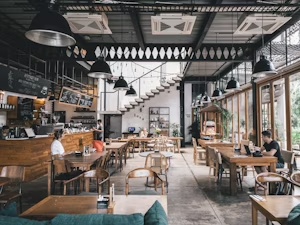
Real-World Success with Commercial Refrigerated Cake Displays
The Sweet Spot, a charming bakery-café in Bristol, was struggling with cake freshness and presentation issues. Their flat counter display left cakes looking uninspiring, with some drying out before they could sell. After installing our curved-glass refrigerated display alongside their espresso machine and bakery equipment, everything changed. 'Our cake sales have jumped by 35%,' reports owner Claire. 'Customers can see our full range beautifully lit and perfectly preserved—they often come in for coffee and can't resist taking home a cake too!'

FAQs
- What temperature should I set for cream-based cakes? Maintain between 4-6°C—keeps cream fresh without drying out cake bases.
- How often should I clean my refrigerated cake display? Clean glass daily and deep clean interior weekly—maintains hygiene and presentation.
- Can I display both sweet and savoury items together? Yes, modern units handle both—just ensure proper food separation to prevent flavour transfer.
- What's the typical lifespan of a quality cake display? With proper maintenance, expect 7-10 years of reliable service—good value for busy establishments.
- Do these units require specialist installation? Most plug-and-play, but consider professional setup for built-in models—ensures optimal performance.
- How can I reduce energy consumption? Keep away from heat sources, maintain door seals, and clean condenser coils quarterly—cuts bills significantly.
Looking for Equipment by Business Type?
Not sure where to start? Whether you're running a bustling café, opening a pizzeria, or managing a school canteen, we've made it easy to shop by business type. Explore handpicked equipment bundles and essentials tailored to your industry—saving you time and making sure you get exactly what you need.
Other Categories You Might Find Useful
We’ve selected some closely related categories that might be essential for your setup. Whether you’re expanding your kitchen or just making sure you’ve got everything covered, these links will help you explore more equipment that fits your needs.
What our Customers Say
'This display has transformed our counter—customers can't resist our cakes now!'
M Melanie Patisserie Owner, Cardiff'Quality build, perfect temperature control, and our desserts look absolutely stunning!'
R Richard Boutique Hotel Chef, Lake District
Why Choose EasyEquipment for Commercial Refrigerated Cake Displays?
- Trusted Expertise 50 years helping bakeries flourish—we know what works.
- Nationwide Delivery Fast shipping throughout the UK—get set up quickly.
- Price Match Guarantee Found it cheaper? We'll match it—fair deals always.
- Dedicated Support Real bakery equipment experts—just a call away.
Ready to Explore Commercial Refrigerated Cake Displays?
Discover our range of premium refrigerated cake displays—the perfect showcase for your bakery or café's finest creations. From compact countertop models to grand curved-glass cabinets, find the ideal solution with fast UK delivery and expert guidance.
#RefrigeratedCakeDisplay
- #BakeryEquipment
- #CaféDisplay
- #PatisserieChiller
- #EasyEquipment
- #UKBakery
- #CakeShowcase
- #ChilledCabinet

